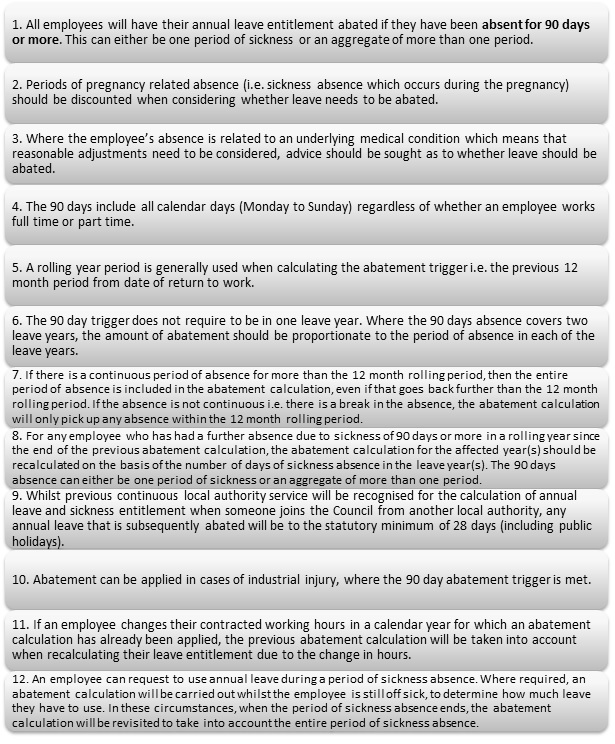- Home
- /
- Leave
- /
- Annual Leave
- /
- Abatement of Leave
On this page you can find a comprehensive overview on abatement of annual leave including definitions, abatement examples and relevant calculations. This information will be of interest if:
- You are an employee who has been absent through illness over a particular period normally exceeding a period of 3 months
- You are a manager with an employee who has been absent through illness over a period of time applicable to his/her terms and conditions
1. Definitions and Scope
The conditions of service for council employees (excluding those under teachers’ terms and conditions) allow for an employee’s annual leave entitlement to be abated to an amount equal to the period of actual service given during the year once they have been absent from work due to sickness for an aggregate period of 90 days or more.
Under the Working Time (Amendment) Regulations 2007, however, employees are entitled to at least 28 days’ annual leave. Therefore, annual leave will only be abated to the statutory minimum of 28 days (pro rated for part-time employees) and inclusive of available public holidays.
Under the Working Time (Amendment) Regulations 2007
Employees are entitled to a minimum of 28 days leave per year and employees must have the opportunity to take the appropriate annual leave entitlement. In order to comply with Working Time Regulations, any abatement must meet the minimum statutory entitlement of 28 days leave (including public holidays) per year.
EP&M Terms and Conditions of Employment state that:
‘where an employee has been absent due to sickness for a period exceeding three months (either one period of sickness or an aggregate of more than one period) over a rolling period of the previous 12 months, annual leave will be abated to a period proportionate to the actual service given during the leave year’.
Chief Officials Terms and Conditions of Employment state that:
‘where an official has been absent through sickness for a period exceeding three months during a leave year’ the authority has discretion to ‘limit the annual leave to a period of at least the proportionate amount equal to the period(s) of actual service given during the leave year’.
The Craftworker Agreement states that:
‘where an employee has been absent through illness for a period exceeding three months the Council will limit the annual leave to the service given during the leave year or statutory obligations’.

2. General Principles

3. Carry Forward of Leave
Any annual leave (subject to abatement) that cannot be taken due to illness must still be available to take on the employee’s return to work (even if the return to work occurs in the following leave year).
In order for their leave to be re-instated, employees must submit a ‘fit note’ indicating that they were unfit for work and over what period. Annual leave should be abated to the statutory minimum (28 days including public holidays) prior to it being carried forward to the following leave year. It is recommended that any days carried forward be used within a specified period e.g. immediately on return from long-term sickness absence or within three months of return to work.
This applies only to long-term sickness cases where employees choose not to take their leave during their period of sickness absence (see below).
4. Requesting Annual Leave during Sickness Leave
An employee can request annual leave during a period of sickness absence and indeed, they should be encouraged to do so in order to avoid a buildup of annual leave which would potentially need to be carried forward into the following leave year.
Where an employee indicates that they intend to take annual leave during a period of sickness absence, or it becomes apparent that they have taken annual leave e.g. because they are unavailable for meetings or occupational health appointments, the relevant days/hours should be deducted from their annual leave card.
Where an employee is on half or nil sick pay they should receive full pay for the leave period and their future half/nil pay dates will be extended by the equivalent number of annual leave days. Notification should be sent to Payroll who will make the relevant amendments. In order to ensure that the annual leave days are excluded from the sickness statistics, the field for ‘hours lost’ should also be reduced by the equivalent number of hours.
Where an employee on long-term sick leave uses annual leave during the period of sickness absence, the number of days taken as annual leave should not be included when calculating the 90 day abatement trigger, nor should they be included as sick days in the first part of the abatement calculation which looks at 365 days in the year minus the number of days off sick. The days taken as annual leave during the period of sickness absence should however be included when calculating how many days leave have been taken in the leave year.
5. Phased Return to Work
For the purposes of abatement of annual leave, the period of phased return should not be included in the abatement calculation. Please see guidance on Phased Return to Work for further details.
6. Payment for Annual Leave
No payment will be made for untaken holidays except on termination of employment, other than in exceptional circumstances.
7. Accounting for Leave that has Already been Taken
If at the point of abatement an employee has used their full leave entitlement, under normal circumstances days/hours will be deducted from their current or next year’s entitlement (providing this would still leave them with the minimum days for that leave year required by the Working Time Regulations i.e. 28 days including public holidays). Where the employee requests it, or where the employee owes more leave than can be deducted from the current or next leave year, the equivalent can be reclaimed in monetary terms through a deduction from salary or the employee can work back the hours (or a combination of these options).
When the abated entitlement is calculated, any days/hours leave already taken during the leave year will be deducted.
8. Communication with Employees
Managers must advise all employees who are absent from work that their annual leave entitlement will be abated if they are absent for an aggregate period of 90 days or more in a rolling 12 month period. Managers should also ensure that arrangements are put in place for employees to carry forward any untaken leave, subject to abatement.
9. Unpaid Leave
The Special Leave Policy (which applies to all Council employees except Teachers and those other employees under SNCT terms and conditions) states the following:
“For periods of unpaid leave which exceed 90 days, annual leave entitlement will be recalculated based on the number of days lost, this will not be less than the statutory minimum annual leave entitlement”.
In practice, this means that the same method of calculation used for abatement of leave due to sickness absence is also applied to periods of authorised and unauthorised unpaid leave. Where an employee has authorised or unauthorised unpaid leave totalling more than 90 days in a rolling 12 month period, the abatement calculation applies.
Where an employee is absent due to sickness for more than 90 days and also has authorised or unauthorised unpaid leave for more than 90 days during a rolling 12 month period, these absence types will be aggregated into one abatement calculation.
10. Calculating Annual Leave Abatement
- 365 days should be used as the full year figure, including in a leap year.
- If an employee whose leave is being abated has worked on a public holiday which fell outwith the sickness absence period then this day should not be included in the calculation. This is because the purpose of including the public holidays in the calculation is to determine whether or not the employee has enough leave in the year (annual leave + public holidays) to meet the statutory minimum of 28 days.
- A half day of absence recorded on PSe should not be included in the abatement calculation.
- Please click on the boxes below to view worked examples for various situations
Change of Hours Part-time Employees Whose Leave is Caculated in Hours
Craft Worker Employee Start or Leave Part Way Through Year
Full-time Employees Maternity Leave During Abated Year
Part Year Employees (47 Week Year) Part Year Employees (non-47 Week Year)
Relevant Documents and Links
Click here to return to the main Annual Leave page
Add a ‘Like’ and/or ‘Rating’ below to indicate how useful you found this page
You must be logged in to post a comment.